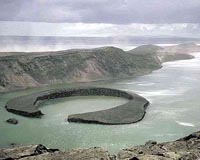| . |  |
. |
Miami FL (SPX) May 05, 2011 An international team of scientists report on the first observatory experiment to study the dynamic microbial life of an ever-changing environment inside Earth's crust. University of Miami (UM) Rosenstiel School of Marine and Atmospheric Science professor Keir Becker contributed the deep-sea technology required to make long-term scientific observations of life beneath the seafloor. During the four-year subsurface experiment, the research team deployed the first in situ experimental microbial observatory systems below the flank of the Juan de Fuca Ridge, which is located off the coast of Washington (U.S.) and British Columbia (Canada). Becker and UM Rosenstiel alumnus Andrew Fisher installed the sub-surface observatory technology known as CORK (Circulation Obviation Retrofit Kit), which seals the sub-surface borehole for undisturbed observations of the natural hydrogeological state and microbial ecosystem inside Earth's crust. "Similar to a cork in a wine bottle, our technology stops fluids from moving in and out of the drilling hole," said Becker, a UM Rosenstiel School professor of marine geology and geophysics. "Ocean water is blocked from entering the hole and flushing out the natural system." These natural laboratories allow scientists to investigate the hydrogeology, geochemistry, and microbiology of ocean crust. A large reservoir of seawater exists in Earth's crust, which is thought to be the largest habitat on Earth. This seawater aquifer supports a dynamic microbial ecosystem that is known to eat hydrocarbons and natural gas, and may have the genetic potential to store carbon. Scientists are interested in better understanding the natural processes taking place below the seafloor, which also give rise to economically important ores along the seafloor and may play a role in earthquakes. "The paper is important since it is the first in-situ experiment to study subsurface microbiology," said Becker, a co-author of the paper.
The new research paper, "Colonization of subsurface microbial observatories deployed in young ocean crust", was published in last month's issue of Multidisciplinary Journal of Microbial Ecology, a publication of the journal Nature.
The paper's co-authors include Becker, Beth Orcutt and Katrina Edwards from the University of Southern California, Wolfgang Bach and Michael Hentscher from University of Bremen in Germany, Andrew Fisher from the University of California Santa Cruz, Brandy Toner from University of Minnesota and C. Geoffrey Wheat from the University of Alaska.
Share This Article With Planet Earth
Related Links Dirt, rocks and all the stuff we stand on firmly
 More evacuated amid Philippine volcano fears
More evacuated amid Philippine volcano fearsManila (AFP) April 17, 2011 Philippine authorities said Sunday more people had been evacuated from towns and villages near a volcano island close to the capital amid increasing signs of seismic activity. The National Disaster Risk Reduction and Management Council said the number evacuated had increased to 1,375 as of Saturday from four towns near Taal volcano, while seismologists recorded 10 volcanic earthquakes overni ... read more |
|
| The content herein, unless otherwise known to be public domain, are Copyright 1995-2010 - SpaceDaily. AFP and UPI Wire Stories are copyright Agence France-Presse and United Press International. ESA Portal Reports are copyright European Space Agency. All NASA sourced material is public domain. Additional copyrights may apply in whole or part to other bona fide parties. Advertising does not imply endorsement,agreement or approval of any opinions, statements or information provided by SpaceDaily on any Web page published or hosted by SpaceDaily. Privacy Statement |